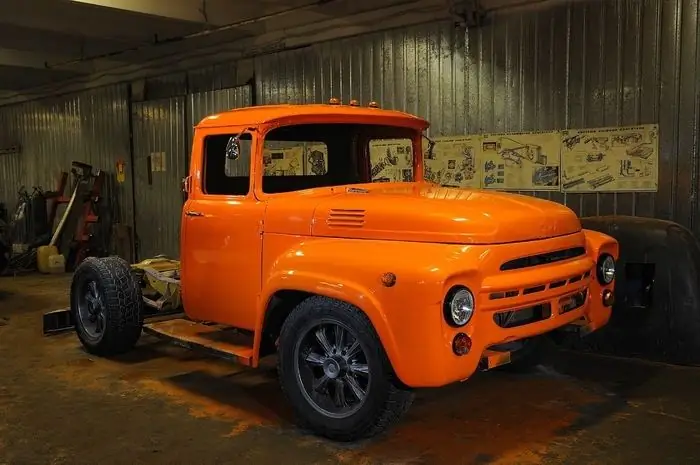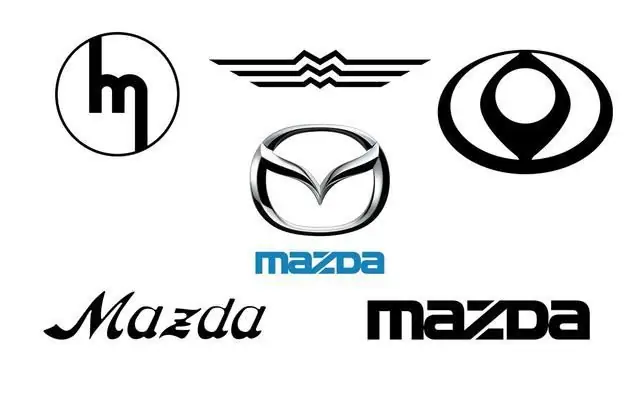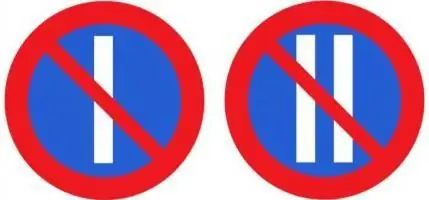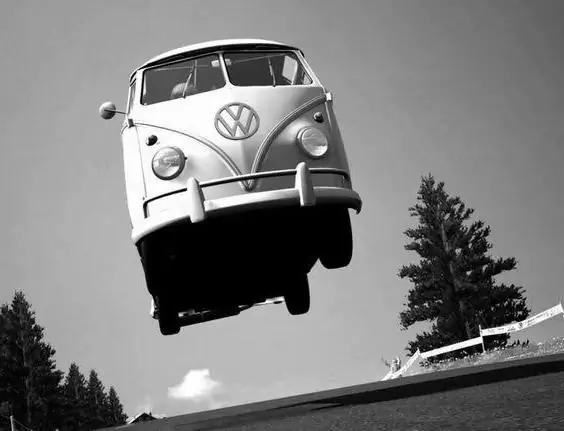2025 Author: Erin Ralphs | [email protected]. Last modified: 2025-01-22 21:14:11
The Volkswagen AG sign belongs to the German automobile concern. The company produces not only cars, but also trucks with minibuses. The head office is located in Wolfsburg. The history of the brand began in 1934, when Ferdinand Porsche (the founder of the famous Porsche AG brand) received an order from the German government to create a modern passenger car accessible to the average citizen.

History of Creation
In 1935, the first car was released under the name Volkswagen AG, which means "people's car". The tests lasted two years, after which its mass production began. A year later, the car received a characteristic and recognizable appearance, which was appreciated by both engineers and drivers. The vehicle quickly became popular, was actively discussed in the press, and was popularly nicknamed the beetle (for its resemblance).
For the mass production of a new car in Wolfsburg, the construction of one of the largest automobile plants in Europe begins. The first line under the VW-30 index was produced in only 12 pieces. The Nazi elite liked the car, Hitler rode it with pleasure. For the period of World War IIthe construction of the plant was suspended, and part of it was reoriented to the military industry.
Post-war years
After the war, the trademark "Volkswagen" came under the control of the British, since Wolfsburg was in their occupation territory. At the end of 1945, the British authorities made an order for 20,000 machines to the plant. Serial production of the car in its original form began only after almost ten years.
In 1947, the brand's products were exhibited at the international exhibition in Hannover, where they attracted close attention. Foreign orders began to arrive at the plant. The first batch of one thousand units was asked by the Dutch. Further, the plant began to cooperate with representatives of Sweden, Belgium, Switzerland and other countries.
In early 1948, the concern was headed by Heinrich Nordhoff, one of the representatives of a new generation of technocrats. The updated leadership includes graduate engineers with experience in the international automotive market and the ability to think outside the box.
Their arrival for the Volkswagen badge was unambiguously positive. Auto significantly modernized and updated. Since 1949, the production of convertibles and limousines began. Production models were equipped with a more comfortable interior, a partially synchronized power unit appeared under the hood.

Beginning of development
Soon the Volkswagen logo became recognizable around the world. We have established a dealer network of car services and technical workshops. Worked actively with clientsfrom different countries. Powerful sales of cars for export made it possible to reach a figure of about 50 thousand units by the end of 1948. Approximately fifteen thousand copies were produced in the domestic market.
During this period, the plant becomes completely the property of the Federal Republic of Germany, freed from the control of the British (1949). A new stage in the development of the concern begins, which is distinguished by an active increase in production capacity and a significant increase in car sales.
Fifties
By the 50th year of the last century, 100 thousand cars were produced from the assembly line, and a year later - half a million copies. In August 1955, a celebration took place on the occasion of the release of the millionth car. The Germans at that time had a special relationship with Volkswagen, they positioned the car as a member of their family. Export opportunities also continued to grow due to the reliability and affordable price of the model. At that time, the Volkswagen sign was already known in more than 150 countries around the world.
Representative offices of the company open in Brazil, South Africa, Australia, Mexico. The main bet is made on the "beetle", which has become a mega-popular modification.
The first interpretation of the classic VW-1200 in 1955 is the Carman Gia sports coupe. The body was designed by the Italians, and it was assembled by a German company. The name of the new model consisted of the names of these companies. In 1961, the VW-1500 came out in a sedan body with an increased volume of the power unit. Coupe and convertible versions were produced on the basis of this car.

Further projects
In 1965, Volkswagen AG bought Audi from Daimler-Benz, creating an enterprise known by the abbreviation VAG. Later, this association included the Spanish company Seat and the Czech plant Skoda. Now Audi is a fully autonomous subsidiary of the concern.
After the merger, the first model was the VW-411, released in 1968. The car was equipped with air cooling, the engine capacity was 1679 cubic meters. see This instance was very indifferently received by consumers. In 1969, a front-wheel drive Volkswagen appeared under the symbol K-70. The car was equipped with engines for 1594 and 1795 "cubes". From 1969 to 1975, the company produces sports modifications together with Porsche. Two more models of those times that are worth noting are the VW-181 with an open body (1970), the Iltis army vehicle (1979).
New Generation
There are few people who do not know what the Volkswagen sign looks like. This indicates the incredible popularity of the machines of this company around the world. The ancestor of the modern generation was the Passat modification with front-wheel drive (1973). It was offered to buyers with different engines, from 1297 to 1588 cubic centimeters.

The following year, the company released the three-door "Sirocco" and the compact hatchback "Golf". The last stamp reached the million mark in the first 30 months of series production. This allowed the German concern to become one of the largest automobile manufacturers in the world. Europe.
Golf modification
Another model produced under the Volkswagen logo was released in 1974. It turned out to be a very successful option, combining efficiency, reliability and modern design. The car in question simply blew up the world market, similar compact cars from different manufacturers began to be almost officially called the golf class.
For example, during the design of new models in 1973-74. the company's losses reached 800 million marks, and a year later, due to an increase in demand, it was possible to fully cover all costs. In 1983, the second generation Golf was released, and the third series was presented in 1991. Over 23 years of serial production, 17 million cars of this series were produced in three generations. In 1997, Golf-4 was presented, for which more than 60 thousand applications were received in the first days after the presentation.
Other Popular Models
In 1975, the sign of the Volkswagen car appeared on another brainchild of the concern - the Polo. This “younger relative” of the “Golf” was similar in design to the “Audi-50”, equipped with “engines” with a volume of 895-1272 cubic centimeters. An inexpensive and practical model quickly became popular, strengthening the financial position of the concern. On the basis of this car, a three-dimensional analogue with a sedan body was produced under the name "Derby".

In the early 80s, the Jetta series (sedan with 4 doors) was released. In the 92nd model was replaced by an analogue based on the "Golf" of the 3rd generation, it was called "Vento". In 1982, the Santana sedan appeared, equipped with a gasolinepower unit with 5 cylinders of 1994 cc. see
From 1988 to 1995 the assembly of the only 3-door coupe "Corrado" in the line was carried out. Since 1993, modifications of the “Sincro Option” have been manufactured on an all-wheel drive chassis with engines of 1.6 and 2.8 liters.
The third generation of the Polo compact car has been in production since 1994. Buyers are offered 3- and 5-door hatchbacks, a classic sedan and a 5-door station wagon. The power units are gasoline and diesel engines with 4 cylinders, from 1 to 1.9 liters and a capacity of 50-100 horsepower.
Volume and roomy station wagon "Sharan" has been produced since 1995 (for 5 or 7 seats), equipped with full or front-wheel drive. Engines have a working volume of 1.9-2.8 liters, power - 90-174 "horses".
In 1996, the fifth Passat family was released. A distinctive feature of this series is the unification with the fourth and sixth "Audi". These modifications go into the series only in the body of a sedan or station wagon with 5 doors. Engines can have from 4 to 6 cylinders, their power is from 90 to 193 horsepower. Some variations are equipped with an all-wheel drive chassis.
History of the Volkswagen badge
The history of the creation of the company's logo is no less interesting than the formation of the concern itself. It is not known for certain who exactly became the founder of the label. Most experts are of the opinion that the first Volkswagen logo was created by Franz Xavier Reimspiss. He was an employee of the Porsche company, improved the engine for the "beetle" of the 30s. As the author of the company markhe was chosen after an open competition.
The letters W and V are combined into a monogram. During the period of Nazi Germany, the old emblem of the Volkswagen was stylized as a swastika. The British returned the logo to its original form, later the black background was replaced with blue. Franz even received an award of 100 Reichsmarks for his work.

VW logo claims
The artist with Nazi views, Nikolai Borg, tried to get recognition from the concern for his authorship on a world-famous label. According to the applicant's lawyer, it was his ward in the 30s of the last century who received an order to develop the emblem. Moreover, the order was given by the Reich Minister for Armaments and Ammunition of Germany, Fritz Todt.
According to the plaintiff's evidence, it can be understood that the first draft of the emblem was made in the summer of 1939. In the fall, Borg received a letter informing him that the design of the badge had been postponed until Germany's victorious finale in the war.
What does the Volkswagen sign mean?
For Nikolai Borg, this emblem is a matter of honor. Despite his poor position, he does not require material compensation from the concern, but simply wants his authorship to be recognized. As additional evidence, the 86-year-old Austrian provided drawings and testimonies of his fellow soldier, who saw the letter, which was later lost. Nevertheless, an attempt to sue the co-authorship of the Volkswagen emblem for Nikolai Borg in the Vienna Commercial Court ended in defeat. The verdict says it's possibleAustrian and drew the design of the logo, but the sign itself already existed long before that.

Result
Now the concern "Volkswagen" is one of the largest automobile companies in the world in terms of sales. The association includes five brands, in addition to cars, trucks, buses of various categories, and SUVs are produced. The production of the Beetle 1, 6 continues in the Mexican representative office, and since 1998 the production of a fundamentally new car, the Beatle, with front-wheel drive has been mastered.
Recommended:
Hyundai logo. History of creation

Hyundai is the leading automotive company in South Korea. The concern's factories produce 8 million cars a year. The Hyundai logo is a stylized H. But few people know that this emblem has a hidden meaning
ZIL-pickup: description with photo, specifications, history of creation

ZIL-pickup car: history of creation, interesting facts, characteristics, features, modifications, photos. Pickup truck based on ZIL: description, restoration, tuning. Converting ZIL-130 into a pickup truck: recommendations, details, how to do it yourself
Mazda logo: history of creation

All companies started their activities with something, and subsequently it was not always this "something" that glorified these companies. This also applies to the world famous car manufacturer Mazda today
Sign "Parking is prohibited": the effect of the sign, parking under the sign and a fine for it

In a modern metropolis, the problem of stopping, and even more so parking, is sometimes much more serious than the movement itself. Still would! Cities are filled to overflowing with cars, and more and more often it turns out that the driver does not stop where it is possible, but where he can perch. And sometimes such tricks end in fines, and in the worst case, sending the car to a car impound
Mercedes sign: description, designation, history and interesting facts

The sign of "Mercedes" today is known to all people. Even those who are poorly versed in the topic of cars. Mercedes-Benz is a world-famous concern, and the cars produced by it have proven to be luxurious, expensive and of high quality. And on the hood of each model flaunts a three-pointed star. What does she mean? How did this symbol come about? Worth sorting out

